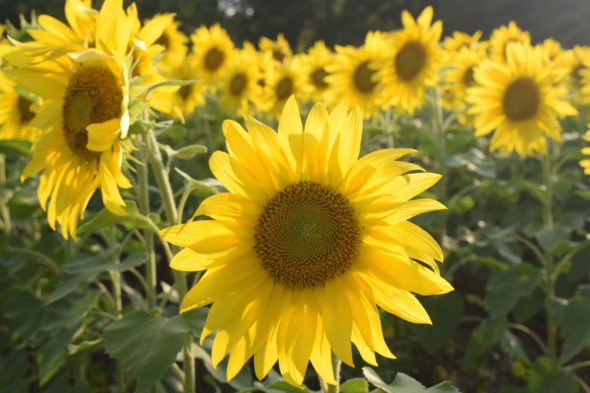
Sunflowers in full bloom along U.S. 68, within Yellow Springs' Green Belt. (News archive photo)
Down to Earth | Green Space Fund enables open space preservation
- Published: May 4, 2024
By Michele Burns
The histories of the Yellow Springs Green Space Fund and the Jacoby Green Belt illustrate the Village Council’s ongoing commitment to uphold the longstanding goal of preserving open space around the Village.
Following the establishment of Glen Helen in the 1930s, discussions began about the importance of green space surrounding Yellow Springs. But it wasn’t until the early 1960s that the community got serious about protecting green space. At that time, Woolpert Engineering was projecting fast suburban development east of Dayton. In 1961, the Yellow Springs Planning Commission proposed a green belt to buffer the Village from suburban encroachment. Glen Helen’s director, Ken Hunt, initiated the Country Commons plan to safeguard land bordering Glen Helen and John Bryan State Park in 1962. Over 500 acres became part of the Country Commons — handshake agreements with neighboring property owners not to develop their land. In 1967, the Village formally adopted the Jacoby Green Belt as part of the first comprehensive plan. Together with Glen Helen, John Bryan State Park, the Country Commons bordering the east, properties along the Jacoby Creek to the west, and the historic Whitehall Farm to the north, the plan for the Village green belt was established.
During the 1960s and 1970s, the federal government provided funding to acquire land or easements for open space to communities with local matching funds. This prompted the establishment of the Green Space Fund, which initially received $25,000 a year from the Capital Fund through sale of electric power. Sutton Farm was purchased in 1966 under this program, along with five easements on Jacoby Green Belt properties. Then, in the 1970s, villagers voted for a 1% income tax that funded green space protection and new business innovation. The Green Space Fund was conceived as an ongoing account, added to each year, and spent when opportunities arose to protect properties within the Jacoby Green Belt, as outlined in the Comprehensive Plan.
In 1990, Tecumseh Land Trust, or TLT, was formed, in part to assist the Village in protecting land within the Jacoby Green Belt. TLT and the Village worked together to acquire two properties and protect them with conservation easements. Those properties were then sold, and the proceeds were returned to the fund.
In 1999, the opportunity to protect Whitehall Farm arrived — 1,000 acres went to auction in 32 tracts. A community grassroots effort was ignited, and $1.2 million was raised in six weeks to save the farm. The entire Green Space Fund, over $200,000, was spent to preserve this property with a conservation easement, thereby curbing development to the north of the village.
The Village has consistently replenished the Green Space Fund whenever money was used to ensure funds were always available for protecting properties within the Jacoby Green Belt. This policy aligned with national and state concerns over loss of prime farmland, and the high ongoing costs of residential sprawl to local governments. In 2001, federal and state funds became available for preserving land. These funds are competitively awarded to preserve the best land, while avoiding areas optimal for development.
Between 2007 and 2011, four more conservation easements were purchased to protect 1,500 acres using Green Space Funds to leverage federal dollars. In 2017, a property located in the center of the Jacoby Green Belt went to auction in multiple tracts. The community and the Village again rose to the occasion and raised $165,000 in four weeks to purchase an easement. In response to the community support for protecting this Green Belt property, TLT secured a five-year federal grant to protect properties within the Jacoby Creek and Yellow Springs Creek watersheds. The Village pledged the entire Green Space Fund to match federal money to protect Green Belt properties through August 2024.
Every Comprehensive Plan since 1967 has included an external Green Belt, a Village goal for over 56 years. Village residents continue to prioritize land protection in the Jacoby Green Belt. There are almost 1,500 acres in the Comprehensive Plan identified for open space protection, some of which will likely sell in the coming years. The Green Space Fund allows TLT to take action quickly when land protection opportunities emerge. TLT continues to work with the Village and participate in land use planning to ensure land being preserved has been identified for permanent protection, and land suitable for development remains available. A healthy Green Space Fund is critical to the ongoing protection of green space around Yellow Springs.
*Michele Burns is executive director of Tecumseh Land Trust and co-owner and operator with her husband, John DeWine, of Flying Mouse Farms.
The Yellow Springs News encourages respectful discussion of this article.
You must login to post a comment.
Don't have a login? Register for a free YSNews.com account.















No comments yet for this article.